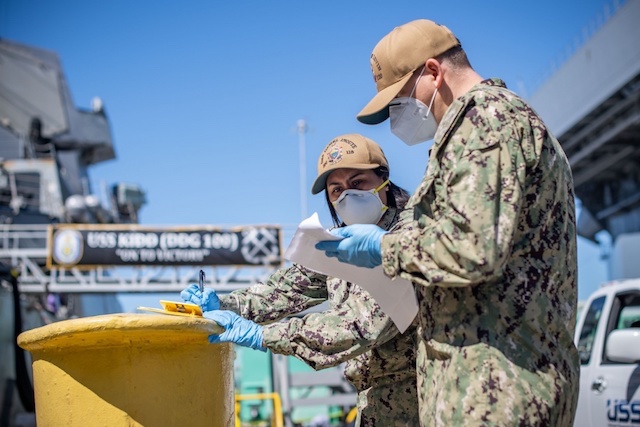The U.S. Navy issued new standardized operational guidance to the fleet to combat the coronavirus pandemic this week.
The guidance lays out minimum actions required for Navy units to deploy safely in this environment. Deploying units across the fleet have already developed effective procedures for restriction of movement, isolation or quarantine periods. These procedures build continuously on lessons learned and are coordinated with the Navy Bureau of Medicine for the latest scientific efficacy and to ensure standardization across the force.
“Our forces continue to operate forward every day. The impact of Covid-19 on the global community only heightens the critical role our Navy plays in maintaining security and stability at sea,” said Vice Adm. Phillip Sawyer, the Navy’s operations chief in charge of coordinating the service’s response to Covid-19.
“As we learn more about this virus, the Navy will continue to take steps necessary to preserve our operational readiness while protecting the health of our forces.”
While testing is the only way to uncover asymptomatic individuals, it does not guarantee a deploying unit is coronavirus-free. Public health mitigation measures, like social distancing, deep cleaning and face coverings, will still be followed to reduce the likelihood of a Covid-19 outbreak once the unit is deployed.
“Personal responsibility and disciplined organizational public health protection measures are the bedrock of risk reduction and risk mitigation,” said Navy Surgeon General Rear Adm. Bruce Gillingham.
The minimum actions to deploy a unit will consist of pre-deployment medical screening, a minimum of 14 days in a pre-deployment restriction of movement sequestered status, and adherence to preventative measures like handwashing and face coverings while underway.
Pre-deployment screening will consist of an assessment of Covid-19 exposure history, a temperature check, a check for Covid-19 signs and symptoms, a review of any past Covid-19 testing, and a thorough evaluation of the member’s high risk factors. The daily screening will consist of a questionnaire and temperature checks.
This guidance will also apply to any ship riders, direct support personnel, and all others penetrating an established clean bubble. These personnel will also be required to complete a 14-day restriction of movement sequestration period prior to embarking. In the event of a short-notice visit aboard a ship, commanders will need to apply case-by-case mitigations to safeguard, to the maximum extent possible, their command’s bubble.
Ships throughout the Optimized Fleet Response Plan must also comply with this guidance. Commands are required to adhere to local Force Health Protection (HPCON) requirements and will be emphasizing the personal responsibility of all hands for wearing face coverings, properly social distancing, self-monitoring and reporting. Daily screenings, health updates, and deep cleaning are also key parts of the policy.
The Navy said that it is imperative that all hands understand the importance of minimizing spread of Covid-19 within its ranks. "We will continue to update our guidance as our understanding of Covid-19 evolves. We can expect these Covid mitigation measures to be in place for a lengthy period, and this will pose challenges for our people and their families. Navy leadership will continue to keep the fleet and families informed on the best way forward during this pandemic," the Navy said.





